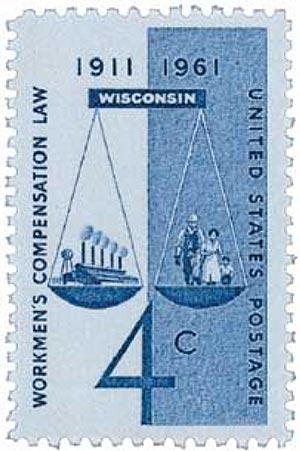
On May 3, 1911, Wisconsin passed America’s first worker’s compensation program. This law provided financial security for workers injured on the job. By 1948, all 48 then-US states had passed such laws. Alaska and Hawaii had workmen’s compensation laws when they joined the Union.
Working conditions in the 1800s were dangerous and hazardous. Between 1855 and 1907, 26 states passed laws that allowed workers to sue their employers. However, these cases were difficult for employees to win. The employers had virtually unbeatable defenses, arguing the worker was also negligent, they knew the dangers of the work, or their injuries resulted from negligence by another employee.
You are watching: 4801

Read more : U.S. Postal Service reveals 20 stamp subjects for 2020
After the Civil War, industrialization boomed, but the number of deaths and injuries in steel mills, railroads, meatpacking plants, coal mines, and elsewhere skyrocketed as well. Initially, most courts stood by earlier decisions that had sided with the businesses. Eventually though, judges and juries ruled more favorably for workers.
In Europe, Otto von Bismarck developed the Workers’ Accident Insurance system in 1881, which served as the model for other nations, including the US. Concerned about the rising cost of court cases, employers began to embrace the idea of adopting worker’s compensation programs. New York, Maryland, Massachusetts, and Montana passed early worker’s compensation laws between 1898 and 1909, but they were all deemed unconstitutional by their respective state courts. In 1908, Theodore Roosevelt signed one of the first federal worker’s compensation laws, the Federal Employers Liability Act, which protected railroad workers and is still in existence today.

Read more : Fit in my 40s: I thought I could use YouTube to learn skateboarding. I was wrong
On May 3, 1911, Wisconsin passed its own Workmen’s Compensation Act, which assured proper compensation for workers injured or made ill on the job. The law created a no-fault system that awarded injured employees regardless of fault. The act further limited the amount of compensation a worker could receive for their injury. The law went into effect that September and a group of Wisconsin employers angered by the new law took it to the state Supreme Court. The court upheld the law, making it the nation’s first workers’ compensation law to be deemed constitutional and survive legal fights.

By the end of 1911, nine more states adopted similar workers’ compensation laws. All 48 states in the Union had passed such laws by 1948. When Alaska and Hawaii joined the Union, they both had workmen’s compensation laws. The workers’ compensation laws of the early 1900s were generally voluntary, meaning the employers weren’t required to purchase the coverage. At one point, employers argued that to make workers’ compensation compulsory was unconstitutional and violated the 14th amendment (requiring due process). In 1917, the US Supreme Court ruled that an employers’ due process wasn’t infringed on by mandatory workers’ compensation. After this ruling, the states instituted their own requirements.

Today, workmen’s compensation provides pay and medical help for people injured while working and provides pensions for their dependents in cases where workers are killed.

Source: https://antiquewolrd.com
Categories: Stamps

